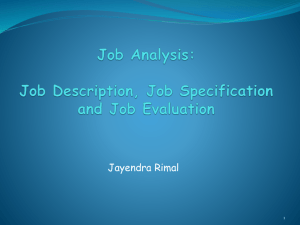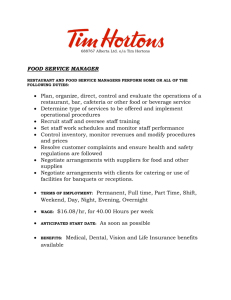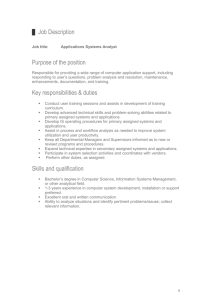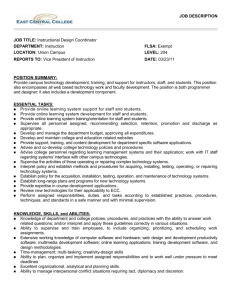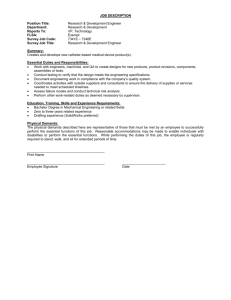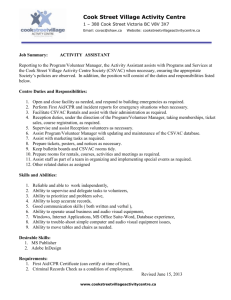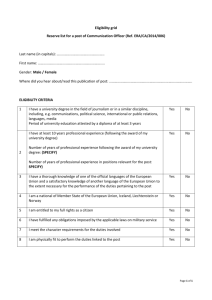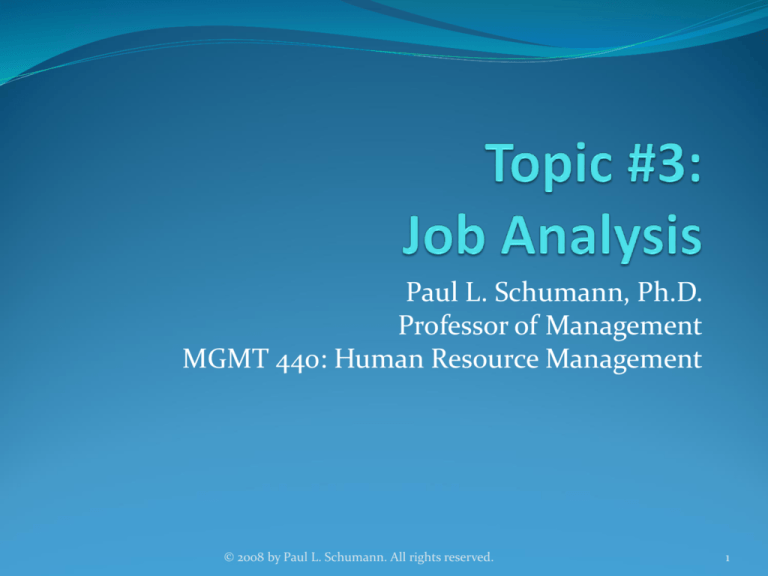
Paul L. Schumann, Ph.D.
Professor of Management
MGMT 440: Human Resource Management
© 2008 by Paul L. Schumann. All rights reserved.
1
Outline
Goal: Match Person & Job
Definitions
Format of a Job Description
Format of a Task Statement
Job Analysis Process
New Views of Job Analysis
2
Goal: Match Person & Job
Person
Job
KSAs
Talents & Interests
Motivation
Tasks & Duties
Rewards
Job Outcomes
Performance
Satisfaction
Need information about the Person & about the Job
3
Definitions
Job Analysis: the process of collecting & analyzing
information about jobs to write:
Job Description: a document that identifies the tasks &
duties performed by a job
Job Specification: a document that identifies the
qualifications required by a job
Most organizations combine the Job Description & the
Job Specification into a single document for each job
Usually simply called a “Job Description”
4
Definitions (more)
Task: a unit of work activity performed by a worker
within a limited time period
Duty: several related tasks that are performed by a
worker
Position: the set of all tasks & duties performed by a
worker
Job: a group of identical positions
5
Format of a Job Description
Example:
http://krypton.mnsu.edu/~schuma
nn/www/teach/sample_job_descrip
.pdf
Common Elements
Job Title
Job Summary
Tasks & Duties
“Task Statements”
Qualifications
Other information
Restaurant Manager
Job Summary:
Plan, organize, direct, and coordinate the workers and resources of the restaurant for the
efficient, well-prepared, and profitable service of food and beverages.
Tasks and Duties:
1. Work with chefs and other personnel to plan menus that are flavorful and popular
with customers. Work with chefs for efficient provisioning and purchasing of
supplies. Estimate food and beverage costs. Supervise portion control and
quantities of preparation to minimize waste. Perform frequent checks to ensure
consistent high quality of preparation and service.
2. Supervise operation of bar to maximize profitability, minimize legal liability, and
conform to alcoholic beverage regulations.
3. Work with other management personnel to plan marketing, advertising, and any
special restaurant functions.
4. Direct hiring, training, and scheduling of food service personnel.
5. Investigate and resolve complaints concerning food quality and service.
6. Enforce sanitary practices for food handling, general cleanliness, and maintenance
of kitchen and dining areas.
7. Comply with all health and safety regulations.
8. Review and monitor, with bookkeeper or other financial personnel, expenditures
to ensure that they conform to budget limitations. Work to improve performance.
9. Perform other duties as assigned by management.
Qualifications:
1. Bachelor of Science degree in hotel/restaurant management is desirable. A
combination of practical experience and education will be considered as an
alternate.
2. Good organizational skills for dealing with diverse duties and staff.
3. Pleasant, polite manner for dealing with public as well as staff.
Reports to:
Supervises:
Date:
Department:
Division:
Approved:
Source (revised from): http://www2.hrnext.com/Article.cfm/Nav/2.4.0.0.6719.0
6
Format of a Task Statement
First word or phrase (required): Performs what action?
(Present-tense verb)
Example: “Supervise …”
Next word or phrase (required): To whom or what is
the action performed? (Object of the verb)
Example: “… operation of bar …”
Next word or phrase (optional): Additional
information
Example: “… to maximize profitability, minimize legal
liability, and conform to alcoholic beverage regulations.”
7
Format of a Task Statement
Example:
http://krypton.mnsu.edu/~schumann
/www/teach/sample_job_descrip.pdf
Each Task Statement is in
the proper format
Optional: Put the Task
Statements in order of:
Task performance
Task importance
Amount of time spent on
each task
No order, but group
related tasks
Restaurant Manager
Job Summary:
Plan, organize, direct, and coordinate the workers and resources of the restaurant for the
efficient, well-prepared, and profitable service of food and beverages.
Tasks and Duties:
1. Work with chefs and other personnel to plan menus that are flavorful and popular
with customers. Work with chefs for efficient provisioning and purchasing of
supplies. Estimate food and beverage costs. Supervise portion control and
quantities of preparation to minimize waste. Perform frequent checks to ensure
consistent high quality of preparation and service.
2. Supervise operation of bar to maximize profitability, minimize legal liability, and
conform to alcoholic beverage regulations.
3. Work with other management personnel to plan marketing, advertising, and any
special restaurant functions.
4. Direct hiring, training, and scheduling of food service personnel.
5. Investigate and resolve complaints concerning food quality and service.
6. Enforce sanitary practices for food handling, general cleanliness, and maintenance
of kitchen and dining areas.
7. Comply with all health and safety regulations.
8. Review and monitor, with bookkeeper or other financial personnel, expenditures
to ensure that they conform to budget limitations. Work to improve performance.
9. Perform other duties as assigned by management.
Qualifications:
1. Bachelor of Science degree in hotel/restaurant management is desirable. A
combination of practical experience and education will be considered as an
alternate.
2. Good organizational skills for dealing with diverse duties and staff.
3. Pleasant, polite manner for dealing with public as well as staff.
Reports to:
Supervises:
Date:
Department:
Division:
Approved:
Source (revised from): http://www2.hrnext.com/Article.cfm/Nav/2.4.0.0.6719.0
8
Job Analysis Process
Source: Fisher, Schoenfeldt, & Shaw (2006), Figure 4.1, p. 141
9
Phase 1: Scope of the Project
Decide purposes of the job analysis project
How do you want to use the Job Descriptions?
Job design
Recruiting
Selection
Performance appraisal
Training
Compensation
Decide which jobs to include in the job analysis project
10
Phase 2: Methods of Job Analysis
Decide what data (information) is needed
At a minimum, for each job being analyzed, we need
data on:
Tasks & duties performed on the job
Qualifications required by the job
Identify sources of job data
Job incumbents: observation, interview, questionnaire
Supervisor of job: interview, questionnaire
Other sources
11
Phase 2: Methods (more)
Select specific procedures of job analysis
Narrative Job Descriptions
Simplest method of job analysis
Collect qualitative data (no numbers)
Examples:
Fisher, Schoenfeldt, & Shaw (2006), Figure 4.2, pp. 148–149
http://krypton.mnsu.edu/~schumann/www/teach/sample_job_descrip.pdf
http://www.jobdescription.com
Engineering approaches: micro-motion studies (time &
motion studies)
Measure body motions involved in performing the job
12
Phase 2: Methods (more)
Select specific procedures of job analysis (more)
Structured Job Analysis Procedures
Functional Job Analysis (FJA): adds to the Job Description 7
scales (numbers) that measure:
3 worker-function scales: % of time spent with:
Data
People
Things
1 worker-instruction scale
3 scales that measure the general educational requirements:
reasoning, mathematics, & language
13
Phase 2: Methods (more)
Structured Job Analysis Procedures (more)
Position Analysis Questionnaire (PAQ)
Standardized questionnaire
Questions focus on worker activities on the job
For non-managerial & non-professional jobs
http://www.paq.com/?FuseAction=Main.PAQProgram
Professional and Managerial Position Questionnaire (PMPQ)
Standardized questionnaire
For professional & managerial jobs
http://www.paq2.com/pmpqmain.html
14
Phase 2: Methods (more)
Structured Job Analysis Procedures (more)
O*NET: Occupational Information Network database
Developed by the US Department of Labor
Standardized descriptors of skills, knowledges, tasks,
occupation requirements, and worker abilities, interests,
and values to assist you in building accurate job descriptions
O*NET Resource Center: http://www.onetcenter.org/
O*NET Online: http://www.onetcenter.org/
Team Project Suggestion: Use “O*NET Online” as a
resource in your Team Project to help write the job
description
Be sure you document in your report the resources you use
15
Phase 2: Methods (more)
Structured Job Analysis Procedures (more)
Task Inventory Procedure
Questionnaire with a master list of possible tasks
Check-mark the tasks done by the job
Other structured Job Analysis procedures:
Critical Incidents Technique
Ability Requirements Scales
Personality-Related Job Analysis Procedures
Cognitive Task Analysis
List of Job Analysis questionnaires with brief descriptions:
http://www.hr-guide.com/data/G012.htm
16
Phase 3: Data Collection & Analysis
Collect job data
Get the organization ready
Reduce sources of bias
Conduct effective interviews
Analyze the job data
Report results to organization
Write the job descriptions
Periodically recheck the job data
Update & revise the job descriptions as needed
17
Phase 4: Assessment
Evaluate the Job Analysis project
Continuous improvement: learn from both successes &
mistakes to continuously get better
Did the project finish on-time and under-budget?
If not, what went wrong? What would you do differently?
Did you collect the correct information?
What additional information would you collect if you did the
project over?
What information would you not collect?
Are the Job Descriptions being used as intended?
If not, what’s missing to make them useful?
18
Job Analysis Process
Source: Fisher, Schoenfeldt, & Shaw (2006), Figure 4.1, p. 141
19
New Views of Job Analysis
Future-Oriented Strategic Job Analysis
Identify the tasks, knowledge, skills, & abilities that will
be needed to perform a job in the future
Instead of describing how a job is today, describe how it will
be in the future
Typically uses experts to help make predictions of the future
Competency Modeling
Identify the observable performance dimensions that
differentiate effective from ineffective employees
Define the job’s critical success factors, which should be tied
to the organization’s objectives and strategy
20
Example of a Job Description
Example of a Narrative
Job Description:
http://krypton.mnsu.edu/~schuma
nn/www/teach/sample_job_descrip
.pdf
How could it be used for:
Job design?
Recruiting?
Selection?
Performance appraisal?
Training?
Compensation?
Restaurant Manager
Job Summary:
Plan, organize, direct, and coordinate the workers and resources of the restaurant for the
efficient, well-prepared, and profitable service of food and beverages.
Tasks and Duties:
1. Work with chefs and other personnel to plan menus that are flavorful and popular
with customers. Work with chefs for efficient provisioning and purchasing of
supplies. Estimate food and beverage costs. Supervise portion control and
quantities of preparation to minimize waste. Perform frequent checks to ensure
consistent high quality of preparation and service.
2. Supervise operation of bar to maximize profitability, minimize legal liability, and
conform to alcoholic beverage regulations.
3. Work with other management personnel to plan marketing, advertising, and any
special restaurant functions.
4. Direct hiring, training, and scheduling of food service personnel.
5. Investigate and resolve complaints concerning food quality and service.
6. Enforce sanitary practices for food handling, general cleanliness, and maintenance
of kitchen and dining areas.
7. Comply with all health and safety regulations.
8. Review and monitor, with bookkeeper or other financial personnel, expenditures
to ensure that they conform to budget limitations. Work to improve performance.
9. Perform other duties as assigned by management.
Qualifications:
1. Bachelor of Science degree in hotel/restaurant management is desirable. A
combination of practical experience and education will be considered as an
alternate.
2. Good organizational skills for dealing with diverse duties and staff.
3. Pleasant, polite manner for dealing with public as well as staff.
Reports to:
Supervises:
Date:
Department:
Division:
Approved:
Source (revised from): http://www2.hrnext.com/Article.cfm/Nav/2.4.0.0.6719.0
21
Outline
Goal: Match Person & Job
Definitions
Format of a Job Description
Format of a Task Statement
Job Analysis Process
New Views of Job Analysis
22

